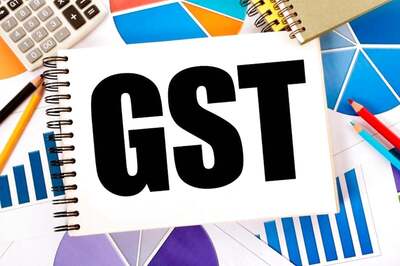
views
Swiggy’s founder and CEO Sriharsha Majety and Zomato’s founder and CEO Deepinder Goyal, arch rivals who dominate the food delivery space in India, have one thing in common
— both of them are famously media shy and hard to pin down for interviews.
Goyal, in fact, stayed away from investor roadshows, analyst meets and media interviews ahead of the Zomato IPO, leaving his top management to do the talking.
Majety broke his silence in a rare interview after Swiggy closed a $1.25 billion funding round, its biggest till date, which will give it ammunition to fight Zomato and stave off Amazon Food, even as it doubles down on non-food delivery categories such as grocery (Instamart), pick up and drop services (Swiggy Genie), subscription-based milk delivery (Supr Daily) and its meat delivery vertical. $1.25 billion is incidentally the same amount that rival Zomato is raising through its IPO.
Majety spoke about the market potential, what the Zomato IPO means for Swiggy, his bets on breakout areas such as grocery and meat delivery, the intense war for talent and why India has huge potential going forward.
EDITED EXCERPTS:
Take us through the kind of interest you saw from investors, what led to the oversubscription?
It is very exciting to have gotten the interest that we did as part of this round and it is great to have many marquee investors including Softbank join the journey. We had strong interest from internal investors as well, with Prosus being a strong supporter. This is a validation of the work that we have been doing not only in food delivery but also the huge opportunity that exists for Swiggy to go after in the next 10-15 years as we kind of build on the beginnings we made in convenience and now make them a much larger part of the business. We consistently heard the excitement from the investors who we spoke with on this ability and how it is super early not only for food but even earlier for convenience in the country and these are white spaces that have the opportunity to build very very huge companies over time. So for us, it is a huge source of excitement and gives us the firepower to go, think long term, make the right investments by category and make sure we do justice to our mission of delivering an unparalleled convenience.
In the run-up we heard something very interesting. Masayoshi Son called you and Zomato before evaluating an investment and finally he decided to go with Swiggy. So what was your pitch to Masa?
The pitch was about the company we are building and the opportunity we are going after. It was literally just that. We were just talking about the company’s mission, and these are the things where we are going to continue making investments. Of course, we are going to invest and grow the food delivery category but also we are very excited about what Swiggy can do for our consumers with the capabilities we have built and the stickiness that we have with our consumers.
So you will use this to accelerate not only your core food delivery business but also expand into some of your newer bets. Can you take us through how are you going to use the money?
There are 3-4 applications. One is of course what we talked about continued investments to grow the food delivery category strongly. But the most significant part of our investments will be into growing our non-food bets like Instamart where we see huge opportunities existing. We are also going to continue investing in hiring for the best talent in technology, data science, capabilities where we think we will always be in good stead in the long term. The last part is we will definitely be exploring the M&A route as well where there are interesting companies that will help us accelerate and get ahead on our own mission.
Any overseas plan apart from these aspects that you mentioned?
No at this time we don’t have any plans of going overseas. India is a huge market even in the urban delivery market of convenience which is still just getting started. Even internally we talk about how like in China, Meituan had close to 500 million users transacting on food delivery last year or the year before last.
Yes, it is estimated that non-home cooked food or restaurant food is only 10 percent of food consumption in India vs 54 percent in the US…
Oh yes, absolutely in food as well as convenience grocery where we are making big progress. Yes, that’s the big thing, as the next 10-15 years emerge, I think there’s going to be many many opportunities in the urban convenience segment and we already believe that just doing justice to these is going to create a very very large business. Every year more uses are going to emerge for our target segment and every year or two we hope to launch a new source offering which really takes off and solves a real problem for consumers. Every year we will be experimenting with multiple things but given the strike rate of inventing every one or two years, we will find opportunities that we look back and say that was larger than food delivery.
Can you take us through the possible segments going forward? What are your plans for Swiggy Genie?
We were prioritising resources and assignments for Genie at a time when it was the most critical service as far as we saw it for consumers. From a business strategy standpoint, Genie indeed got a huge amount of awareness during the second wave of the lockdown which kind of expanded the opportunity beyond what we saw for the next year but I think more significant bets are still going to be in Instamart and grocery.
What’s your appetite for M&A? Will you dedicate some portion of the funding for that?
Definitely we will be allocating a good part of the fund raise to the M&A strategy. There are a lot of exciting companies getting built and we want to dig in and see how we can partner together to drive stronger growth.
How should we visualise Swiggy going forward? Will it be a mix of say a DoorDash and a GoPuff?
Our mission is to deliver unparalleled convenience to urban consumers. So you will definitely see us offering a lot more offerings in the next 5-10 years, we will continue inventing and figuring out what our consumers need and how we can serve them better. So that is the path that we are going to take. Even as we speak right now from being a small dot on the radar, our non-food revenues are close to a quarter of our overall revenues. Food delivery is also going to grow strongly. As we go into the next few years, we will look to build on it and go increase the share of the non-food bets also. We have Instamart, Genie, the meats vertical…
Swiggy’s sweet spot used to be the office going crowd. A lot of them are still in their hometowns. How do you see this panning out? The average order values have gone up for players because people are ordering as families. Where are you in terms of numbers when you compare this to pre-Covid?
The overall volumes and the sales are higher than pre-Covid already. We are already 30 percent higher in order value than pre-Covid and continue to see strong momentum in that. There are a new set of users and use cases. Some of it may not exist but then we also will test the return of the offices and more of our core customers.
You have brought down your burn rates to single digits, compared to the double digits that you had a few years ago. Can you give us a sense, where you are, will it continue with that sort of efficiency post-pandemic?
It will depend on multiple categories and in what stage we are in. In categories where we believe there are breakout potential and we need to go into more geographies, spread the word among more users, we will invest and in food delivery as you rightly pointed out significantly improved the unit economics and they are in a very healthy place. But even there we will continue investing in marketing awareness improving the customer experience to build on it further. The overall investment potential is still going to be high.
Is there a path to profitability that you have in mind as you go about investing in some of these areas?
Again it is a category wise view. The food delivery business has demonstrated a clear path to profitability. Will it happen in two years or three years, that’s what we are discussing. The new verticals, we are building them definitely with the right proof points not only on consumer large but to give into the peak in terms of long term profitability and viability of these models. The path to profitability will be a function of the overall portfolio choices we make. At this stage in the next few years you will see maybe the extra second, third, fourth business also getting into unit economic positive and because they are all building on the food delivery backbone and incremental cost in terms of reach or awareness of technology are lower for each new business, we will hit overall profitability faster.
Let’s address the elephant in the room which is the Zomato IPO. What is your reaction to it in terms of the overwhelming response it has seen? Does it put pressure on you? Did you call up Deepinder Goyal to wish him luck?
These are very exciting times for the Indian startup ecosystem in general. Secondly, it is actually great to see, a public market valuation for the category that we are. We would like to wish all the companies including Zomato that are going public this year, all the best. In terms of pressure, there is no pressure. For us, we are completely focused on our own mission, caring for the investments that we need to make to do justice to what we started out with. That changes nothing. It is an exciting time and strong validation in the public market.
The inevitable question now is if Swiggy will also plan to list and when? I know you are a younger company comparatively
We are a younger company. We have our own strategy and investment plans. We want to do justice to them. Are we thinking about it — yes but there are no clear actionable at this point.
Restaurants accuse aggregators of taking away their business. NRAI has been opposing companies. How do you plan to address this area of concern in the market?
Like in any category convenience, selection and price all are important in a healthy way to drive long term growth and viability for the category. So we are fully mindful of that. For us the job is to continuously listen to our restaurant partners and we are committed to even more improve how we can work together to be able to offer the right kind of promotions to continue the growth of the category. We have even launched some pilots like Swiggy Direct etc to address some of the problems that they are talking about. We are going to do a lot of things in the next few quarters taking all the feedback and are committed to growing a lot more.
So Swiggy is open to unbundling the services?
100 percent.
What all is in store?
The last pilot that we launched with direct is one example. Rest assured we are going to do a lot of this subject over the next few quarters. For us it has always been about how do we actually offer these solutions that are both restaurant backwards as well as consumer backwards and we are increasingly able to see a lot of such opportunities and unfortunately can’t talk about them right now.
Have you heard from the CCI on the NRAI complaint?
We haven’t had any official communication.
What is the impact of Amazon Food so far? They are running pilots in Bengaluru since May last year? Is that going to be another near-term challenge?
Definitely watching them closely. There are always opportunities to learn if someone else is doing something differently. At this point it isn’t already clear yet if it is a challenge or not. In terms of what we do, it doesn’t change much in the interim. If they have opportunities to do better, we have to do it even faster this month.
But the big discounts we see on your app, from 40-60 percent, is it here to stay?
Part of what you see are also events that companies run when there is a season when you can go after acquiring a new bunch of users. In general, discounts will not go away completely. There is a right amount needed to grow the category. But I guess these are also things that are going to be seasonal.
In terms of how Instamart worked out for you as a breakout category- how will it compete with Amazon, BigBasket, Grofers and Flipkart. Will you expand beyond Bengaluru and Gurugram?
Instamart is in the convenience grocery segment and we think it solves a very real need for our user base at Swiggy and that is what we are going to be focussed on. Convenience grocery coming very quickly at your home for the urban consumer. There are many groceries in India and this is the grocery we are going after.
In terms of food delivery, Genie, Instamart, Supr Daily- they are all very different businesses. Is there a common layer- how are you breaking it up and directing your resources?
Common layer is the user base and the last mile logistics infrastructure which we built for food delivery but have already made incredible progress making it multi tenant and making it serve multiple needs of different categories. With Genie, it is a complexity of organising ourselves and our fleet, in Instamart we need to build new muscle to understand the needs of the segment. The people and the culture- we are hiring entrepreneurial people who come with a lot of passion and expertise and letting them run and invent that is set up for invention is one part. But you also have to be patient as a company and invest for the long term. There are multiple ambitious companies in food delivery doing more for consumers and we are also going to be amongst them.
One big challenge that every startup is talking about is talent. Bharat Pe for instance is now offering BMW superbikes for tech talent. How are you retaining and hiring talent?
The biggest reason for any high-quality talent to join companies is the challenge and the nature of problems to be solved. We are a 3-sided marketplace, where restaurant, delivery partner and consumer have to come together in 30 minutes. It is a candy store for people looking for exciting problems to solve. If you combine that with our ambition to do more and the entrepreneurial culture, these are the fundamental drivers that attract people to Swiggy.
But would you agree that the war for talent, cost of hiring has intensified?
There is definitely an intensive talent war because there are many startups getting off the ground faster than they have, growing faster than they ever have. The intensity is quite high.
You recently took on the additional responsibility of COO, with Vivek Sunder planning to step down. You also elevated Phani Kishan to co-founder. How are you building out the management layer at Swiggy?
In terms of building out management team, there are no plans to expand the management team per se. Indeed we are looking for Vivek’s replacement like you mentioned.
Read all the Latest News, Breaking News and Coronavirus News here.




















Comments
0 comment